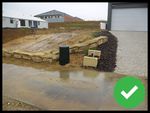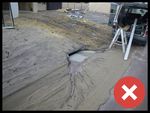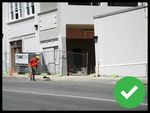SEDIMENT TASK FORCE - FOR BUILDERS - EROSION AND SEDIMENT CONTROL FOR BUILDERS - SEDIMENT TASK FORCE - KEEPING SOIL ON SITE - Perth NRM
←
→
Page content transcription
If your browser does not render page correctly, please read the page content below
SEDIMENT TASK FORCE - KEEPING SOIL ON SITE
SEDIMENT TASK FORCE - FOR BUILDERS
EROSION AND SEDIMENT CONTROL FOR BUILDERS
STF IS-BA-1Erosion and Sediment Control for Builders
This Information Sheet provides guidance to builders and homeowners on the erosion and sediment control
measures that should be implemented on building sites in Western Australia. It has been prepared acknowledging
that a one-size-fits-all approach may lead to unnecessary buildings costs.
It’s the law! Government Authorised Officers inspecting building sites can issue penalties of up to $5,000 for
individuals and $25,000 for a corporate body for non-compliance with erosion and sediment control regulations.
The builder or manager The site supervisor or
has prime responsibility for foreman is responsible The individual trades
controlling and supervising for coordinating and carry responsibility for
the construction operation establishing good their work and actions.
including all site works. practices on site.
10 Financial Benefits to You
Controlling erosion and sediment on building sites reduces the potential for financial loss to builders by:
1. Reduced risk of fines or prosecution for polluting the environment.
2. Economical and efficient use of sand for building sites, and as fill.
3. Reduced clean-up costs.
4. Better “all-weather” site access and improved wet weather working Treat preventing erosion
conditions. and controlling sediment
5. Better tender processes (companies with a poor compliance history loss and sand drift as
may be subject to more stringent conditions). importantly as your health
6. Work completed on time and reduced downtime. and safety obligations
7. Fewer complaints related to mud, sand drift, dust and stormwater
pollution.
8. Public recognition for responsible site management.
9. Improved relationships with local councils and the community.
10. Promoting and associating your business with protecting the environment.
Your Actions Benefit Your Community and the Environment
Controlling erosion on your building site improves water quality and protects
the environment as sediment (soil, mud, silt and builders sand) runoff from
building sites can enter the drainage network and be deposited into rivers and
wetlands, resulting in sedimentation.
Sedimentation causes multiple undesirable economic, environmental,
recreational and health and safety impacts. It also increases the risk of localised
flooding from the “clogging” of drains and Water Urban Sensitive Design
infrastructure and degrades recreational values and the streetscape.
Be part of the solution – do the right thing by our rivers and
comply with environmental regulations by preventing erosion
and sediment run-off from your site reaching roads, gutters,
drains, wetlands, streams & rivers.
2Start with a Site Assessment - Is your site low risk, medium risk, or high risk?
Low Risk Medium Risk High Risk
Soils comprised of coarse sand Soils comprised of mainly sandy Soils comprised mainly of clay and
clays or silts silt material
Undisturbed vegetation onsite Property and surrounding slopes Presence of dispersive clay soils
between 1:10 and 1:4 onsite and downstream
Property and surrounding slopes No waterways (creeks, rivers, Property and surrounding slopes
1:4
development boundary or within
100m downstream
No waterways (creeks, rivers, No downstream drainage Downstream waterways (creeks,
streams, wetlands) within the infrastructure (roadside entry rivers, streams, wetlands) within
development boundary or within pits, grates, pipes, Water Urban 100m of property boundary
250m downstream Sensitive Design infrastructure (including any waterways within
(rain gardens etc) the property)
Waterways (creeks, rivers,
streams, wetlands) within the
development boundary or within
250m downstream
Ensure contingency plans are in place for unexpected high rainfall or storm events such as
sediment fence materials located in advance on-site to facilitate emergency repairs.
During pre-construction planning of site works, landowners and occupiers (including builders and
contractors) should undertake a site assessment and apply the appropriate erosion and sediment controls
for their site risk.
If your site meets any of the criteria in the higher risk categories, that is the risk level to apply. If you are
unsure of how to assess your site, contact your Local Government Authority.
Sediment controls can be up to 90% effective at reducing sediment runoff during normal flow. The
effectiveness of sediment controls reduces dramatically during storm events, so make sure your site is well
prepared and your sediment controls are regulary inspected and maintained (weekly, at minimum) and
after during and after every rainfall event to ensure they are working properly.
Remember, each site is different and effective erosion and sediment control should be based on your sites’
local soil and rainfall conditions. Builders should check the weather forecast to ensure clean sites ahead of
any wet weather.
As little as five minutes of
sweeping of footpaths,
roadways and driveways
at the end of each working
day is relatively inexpensive
and provides considerable
benefits (DBCA).
3Low Risk Sites
The following sediment controls represent the minimum requirements for all building sites. All control measures
should be maintained until the completion of all earthworks and landscaping, and disturbed areas have been
rehabilitated. Where repair works or additional controls are required, they must be installed as soon as possible to
prevent further sediment movement on the site.
The focus of these controls is to ensure a clean building site and prevent building materials and litter leaving the site.
• Maintain a clean site, including sweeping up loose material and placing all waste material in bins (with regular
collection).
• Ensure all wash down areas (including concrete and mortar slurries and tools) are contained within the site and
the wash down zone is well away from drains.
• Do not allow material to enter drainage systems.
• Set up vehicle access points away from storm drains.
• Stop sand, mud or soil from moving to or entering stormwater entry pits.
• Install sediment bunding around drains and stormwater drain inserts in gully entry drains if necessary.
• Educate all staff about the requirements to maintain a clean site and prevent wash down of wheelbarrows on
driveways.
• For larger lots, vegetation should be retained and replaced as quickly as possible if removed.
Covering soil is the best way to stop erosion caused by rain and wind*
Medium Risk Sites
These sites must implement the basic controls outlined above for low risk sites (above).
As the risk of erosion is increased, additional measures are required which focus on building site arrangement:
• Define a single site access location and prevent contractors driving over
exposed surfaces such as unplanted verges or front yards.
• Stabilise the site access location using crushed rock (150-200mm deep
pad of minimum 40mm crushed rock), with a hump to divert flow from
the road.
• Consider using trackout mats.
• Minimise material stockpiling by scheduling deliveries. Place material
within the lot and away from the roadway.
• Store sand within bags (where possible) and locate material stockpiles
within the lot boundary (away from verges) and 2m away from driveways
and other hardstand areas.
• Cover stockpiles with plastic sheeting or other material.
• Stabilise slopes to prevent erosion.
• Implement sediment control fences.
• Careful site planning can minimise the number of physical controls that
are required for effective management.
• Consideration should also be given to any land upstream to divert flows
away from your building site.
4High Risk Sites
High risk sites have the potential to directly impact downstream drainage infrastructure and natural waterways.
Additional measures are required to protect these systems include:
• Sediment traps (multiple sandbags or filter socks) installed in the roadway
upstream of kerb inlets (ensuring flows are not directed to other drainage
inlets).
• Sediment traps (multiple sandbags or filter socks) around grated drainage
inlets and inlets in road sags (ensuring flows are not directed to other
inlets).
• Sediment fences installed around any waterways within the property.
• Connection of the roof gutters to soakwells or street drainage, with
temporary connections provided during construction (see over).
• Rainwater tank overflows connected as per soakwells.
These measures should be implemented in addition to the measures for low
and medium risk sites. They require regular inspection and cleaning to prevent
sediment build up. Ongoing adjustments to the layout of sediment traps may
also be required to ensure they are effective.
A Free Handy New Tool for your Builders’ Toolbox
Site managers and builders can use the Sediment Task Force’s On-Site Builders Checklist when arriving at and leaving
site for regular checks of sites and vacant blocks, and before and after a rain, wind or storm event.
Erosion and Sediment Control Information Sheets are also available at:
www.perthnrm.com/resource/sediment-management/
5Further Information
Guidance provided in this Building Information Sheet is general and specific site erosion and sediment control designs
may be required to ensure compliance with individual Local Government Authorities’ Local Laws. Contact your Local
Government website or enquiry line. Also check out:
Sediment Task Force Resources (including Builder’s Checklist)
Housing industry Association (WA)
Master Builders Association
YourHome - Sediment Control
IECA (Australasia) - Resources
IECA (Australasia) - Best Practice Erosion and Sediment Control (BPESC) Document
For the Latest Innovations in Erosion and Sediment Control
International Erosion Control Association (Australasia) - Environmental Excellence Awards
The Sediment Task Force gratefully acknowledges the input from the following organisations: Housing Industry
Association (WA), the Department of Biodiversity, Conservation and Attractions and Healthy Land and Water, and
to the Shire of Augusta-Margaret River for allowing us to base this Information sheet on their Sediment and Erosion
Management Building Information Sheet 2018.
The Sediment Task Force is funded by the Department of Biodiversity, Conservation and Attractions (DBCA)
and supported by Perth NRM
© Perth NRM, 2021
Front Cover Photo supplied by Burst and PexelsYou can also read



























































